
NGC 5566 is a barred spiral galaxy in the constellation Virgo, which is approximately 66 million light years away from Earth. The galaxy is the biggest in the constellation Virgo, stretching nearly 150,000 light years in diameter. The galaxy NGC 5566 was discovered on 30 April 1786 by the German-British astronomer William Herschel. It is included in Halton Arp's Atlas of Peculiar Galaxies. It is a member of the NGC 5566 Group of galaxies, itself one of the Virgo III Groups strung out to the east of the Virgo Supercluster of galaxies.
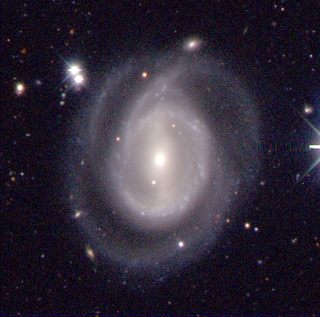
NGC 53 is a ringed barred spiral galaxy in the constellation Tucana. It was discovered by John Herschel on 15 September 1836. He described it as "very faint, small, extended". The galaxy is approximately 120,000 light-years across, making it about as large as the Milky Way.
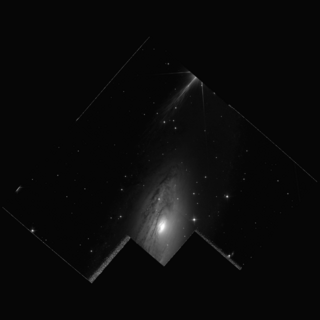
NGC 7013 is a relatively nearby spiral or lenticular galaxy estimated to be around 37 to 41.4 million light-years away from Earth in the constellation of Cygnus. NGC 7013 was discovered by English astronomer William Herschel on July 17, 1784 and was also observed by his son, astronomer John Herschel on September 15, 1828.
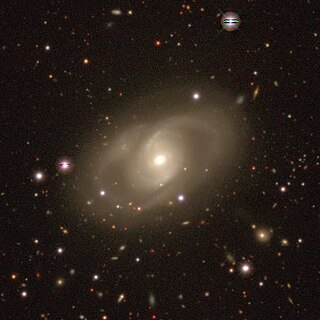
NGC 7060 is an intermediate spiral galaxy located about 200 million light-years away in the constellation of Microscopium. The spiral arms of NGC 7060 appear to overlap. NGC 7060 was discovered by astronomer John Herschel on September 2, 1836.
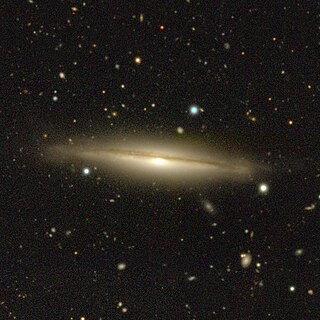
NGC 482 is a spiral galaxy in the constellation Phoenix. It is located approximately 277 million light-years from Earth and was discovered on October 23, 1835 by astronomer John Herschel.
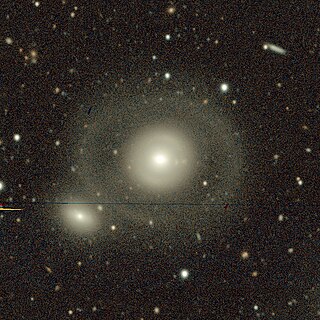
NGC 483 is a spiral galaxy in the constellation Pisces. It is located approximately 192 million light-years from Earth and was discovered on November 11, 1827 by astronomer John Herschel.

NGC 485, also commonly referred to as PGC 4921 or GC 270, is a spiral galaxy in the constellation Pisces. It is located approximately 86 million light-years from Earth and was discovered on January 8, 1828 by astronomer William Herschel. It was later also observed by Heinrich d'Arrest and Herman Schultz. When NGC 485 was originally categorized in the New General Catalogue by John Louis Eil Dreyer in 1888, it was incorrectly described as a "considerably faint, pretty large, round, 8th magnitude star 3 1/2 arcmin to southwest".
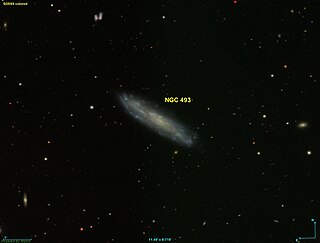
NGC 493, also occasionally referred to as PGC 4979 or GC 281, is a barred spiral galaxy in the constellation Cetus. It is located approximately 90 million light-years from Earth and was discovered on December 20, 1786 by astronomer William Herschel. It was later also observed by his son, John Herschel. John Dreyer, creator of the New General Catalogue, described the galaxy as "very faint, large, much extended 60°" with "a little brighter middle".

NGC 494, also occasionally referred to as PGC 5035 or GC 282, is a barred spiral galaxy in the constellation Pisces. It is located approximately 227 million light-years from Earth and was discovered on 22 November 1827 by astronomer John Herschel. John Dreyer, creator of the New General Catalogue, described the galaxy as "very faint, pretty large, extended, 3 faint stars to south".

NGC 495, also occasionally referred to as PGC 5037, UGC 920 or GC 278, is a barred spiral galaxy in the constellation Pisces. It is located approximately 184 million light-years from the Solar System and was discovered on 12 September 1784 by astronomer William Herschel.

NGC 496, also occasionally referred to as PGC 5037, UGC 927 or GC 288, is a spiral galaxy in the constellation Pisces. It is located approximately 250 million light-years from the Solar System and was discovered on 12 September, 1784 by astronomer William Herschel.

NGC 499, also occasionally referred to as PGC 5060, IC 1686 or GC 289, is a lenticular galaxy in the constellation Pisces. It is located approximately 197 million light-years from the Solar System and was discovered on 12 September, 1784 by astronomer William Herschel.

NGC 1510 is a dwarf lenticular galaxy approximately 38 million light-years away from Earth in the constellation of Horologium. It was discovered by John Herschel on December 4, 1836.

NGC 512, also occasionally referred to as PGC 5132 or UGC 944, is a spiral galaxy in the constellation Andromeda. It is located approximately 217 million light-years from the Solar System and was discovered on 17 November 1827 by astronomer John Herschel.

NGC 513, also occasionally referred to as PGC 5174 or UGC 953, is a spiral galaxy in the constellation Andromeda. It is located approximately 262 million light-years from the Solar System and was discovered on 13 September 1784 by astronomer William Herschel.

NGC 1436 is a barred spiral galaxy approximately 58 million light-years away from Earth in the constellation of Eridanus. It is a member of the Fornax I cluster.

NGC 521, also occasionally referred to as PGC 5190 or UGC 962, is a barred spiral galaxy located approximately 224 million light-years from the Solar System in the constellation Cetus. It was discovered on 8 October 1785 by astronomer William Herschel.
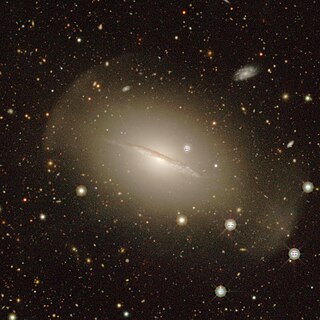
NGC 681 is an intermediate spiral galaxy in the constellation of Cetus, located approximately 66.5 million light-years from Earth. The name Little Sombrero Galaxy is a reference to a much larger and earlier observed sombrero-like galaxy designated M104, or the Sombrero Galaxy.
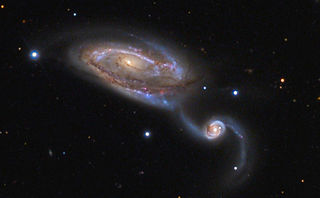
NGC 5395 is an interacting spiral galaxy located at a distance of 160 million light years, but receding away from the Earth at 3511 kilometers per second, in the constellation Canes Venatici. It was discovered by William Herschel on May 16, 1787. NGC 5395 and NGC 5394 are included in the Atlas of Peculiar Galaxies as Arp 84 in the category "Spiral galaxies with large high surface brightness companions".

NGC 6902 is an unbarred spiral galaxy located in the southern constellation of Sagittarius at an approximate distance of 124 million light-years (38.0 Mpc). NGC 6902 was discovered on September 2, 1836 by English astronomer John Herschel. In his New General Catalogue, Danish astronomer J. L. E. Dreyer described it as faint, considerably small, round, brighter middle. It is a member of the small NGC 6092 group of galaxies; the LGG 434 group




















